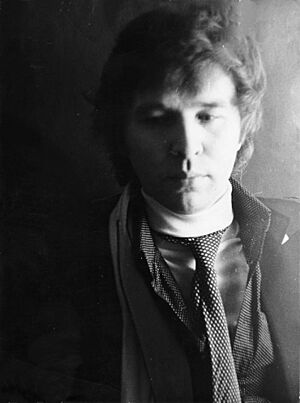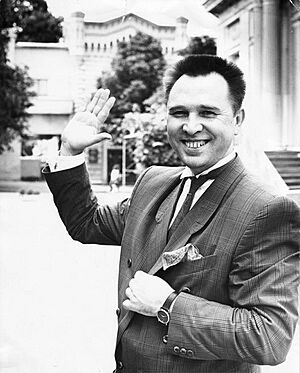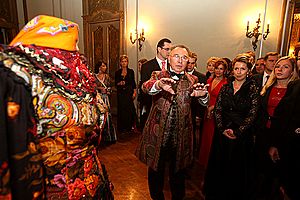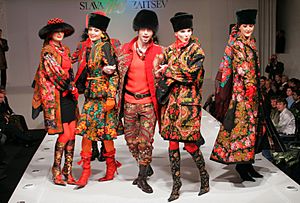Vyacheslav Zaitsev facts for kids
Quick facts for kids
Vyacheslav Zaitsev
|
|
|---|---|
| Вячеслав Зайцев | |
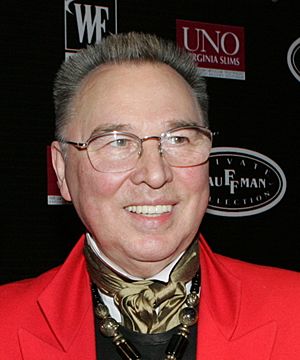 |
|
| Born |
Vyacheslav Mikhailovich Zaitsev
2 March 1938 Ivanovo, Russian SFSR, Soviet Union
|
| Died | 30 April 2023 (aged 85) Shchyolkovo, Moscow Oblast, Russia
|
|
Label(s)
|
Slava Zaitsev |
| Awards | Fashion designer, painter, artist |
Vyacheslav "Slava" Mikhailovich Zaitsev (Russian: Вячеслав Михайлович Зайцев; born March 2, 1938 – died April 30, 2023) was a famous Russian fashion designer. He was also a painter, graphic artist, and designed costumes for plays and shows.
Contents
Early Life and Education
Slava Zaitsev was born in Ivanovo, Russia, on March 2, 1938. His father faced difficulties during the time of Joseph Stalin, which affected Slava's chances to study certain subjects.
From 1945 to 1952, he went to Secondary School № 22 in Ivanovo. Even though he faced challenges, he started studying applied arts at the University of Chemistry and Technology in Ivanovo in 1952. He became very interested in making textiles and learned to be a textile artist. He finished his studies with top honors in 1956.
Slava loved working with fabrics. So, in 1956, he moved to Moscow to study at the Moscow Textile Institute. He graduated in 1962 with a degree in painting and design. During his time at the institute, he got married to Marina Vladimirovna Zaitseva in 1959. They had a son named Yegor in 1960.
Fashion Career
Starting in the Soviet Union
During the time of the Soviet Union, Slava Zaitsev was one of the most important fashion designers. People often compared him to famous Western designers like Christian Dior and Yves Saint Laurent. Many believed he could compete with them on a global scale. However, because of the rules in the Soviet Union, he could only work outside the country in Czechoslovakia.
In March 1962, he started working as the art director at a factory in Moscow. There, he was in charge of making women's clothes for stores. He became well-known in 1963 for designing stylish versions of traditional Russian clothing. This included warm jackets called telogreika, skirts inspired by Pavlovsky Posad shawls, and colorful felt boots called valenki. Even though his designs were praised for being bright and colorful, they were not approved for mass production.
In February 1963, a French magazine called Paris Match wrote about Zaitsev. They were the first foreign media to feature him and spoke highly of his designs.
In March 1965, Zaitsev became the Chief Designer at the All-Union Fashion House in Moscow. This place was also known as Dom Modeli. In April 1965, famous French designers like Pierre Cardin visited Moscow and saw Zaitsev's work. Pierre Cardin called Zaitsev "an equal among equals." The French newspapers even called him the Red Dior. From 1965 to 1968, Zaitsev's designs, known as the Russian series, were shown in other countries.
In 1978, Zaitsev left the All-Union Fashion House and started his own small studio. He also began writing poetry around this time. He designed the costumes for the Soviet team at the 1980 Summer Olympics in Moscow. For this, he received an award called the Order of the Badge of Honor. He also wrote two books about fashion in 1980.
In 1982, his studio became the «Slava Zaitsev» Moscow Fashion House. This made him the first Soviet couturier (a designer of high-fashion clothing) allowed to put his own label on clothes. By the mid-1980s, his fashion house had 600 employees. They had to produce a lot of clothing each year. In 1984, it was reported that they had served 10,000 customers. Prices for ready-to-wear dresses were around $170 to $260, and custom-made gowns could cost up to $1,000.
Raisa Gorbachyova, the wife of the Soviet leader, wore Zaitsev's designs in the 1980s. This made him very famous around the world and a household name in Russia. Zaitsev's fashions were shown at Expo '85 in Japan. In 1986, he was finally able to visit a Western country when he showed his work at Expo 86 in Canada.
Zaitsev was a member of the Communist Party. However, he started to feel unhappy with the party in the late 1980s. He wanted more freedom, as he believed the party's rules stated. He often complained to the Soviet leaders about not having enough materials for his designs. For example, he had to use old dressmaker's mannequins from World War II until recently.
In August 1987, Zaitsev signed a deal to sell his designs in the United States. This was a big step, as it was the first time a Soviet design house could keep its profits instead of them going to the government. In October 1987, he showed his collection in New York City.
In 1988, he designed costumes for a musical show called Sophisticated Ladies in New York City. In January 1988, he had his first Paris fashion shows. He was invited by Madame Carven and showed his collection under the name "Russian Seasons." He also became an honorary citizen of Paris. The next year, in March, he was named "Man of the Year in the World of Fashion."
In September 1989, Zaitsev showed his collections in West Germany for the first time. In December 1989, he won first prize at a competition in Tokyo, Japan. He competed against other top designers like Donna Karan.
After the Soviet Union
After the Soviet Union ended, Zaitsev's business changed. Before, the government paid for his work. Now, he had to fund his business himself. Many of his new customers were wealthy Russians.
In 1991, he designed a new uniform for the Russian police. He was also given the title of Honored Worker in the Field of the Arts. By 1992, famous people like Jane Fonda were buying his clothes. In the same year, Zaitsev launched a women's perfume called Maroussia with a French company called L'Oréal. This perfume is still made today.
1992 was also important because Zaitsev showed his fashion collection, paintings, and drawings in New York and Beverly Hills for the first time. Before this, his personal artwork was not allowed to be shown publicly because it didn't fit the government's art style.
In 1994, Zaitsev started the Nadezhda Lamanova Prize competition for Russian designers. In 1996, he started a competition in Russia with the slogan "Goodbye Barbie, welcome Maroussia." He wanted to find the "purest essence of" Russian teenage girls. He felt that Barbie dolls were too "rigid, cold, cynical," and he wanted to promote a different idea of beauty for Russian children.
Zaitsev designed clothes for Vladimir Zhirinovsky for his 1996 Russian presidential campaign. On May 27, 1996, President of Russia Boris Yeltsin gave Zaitsev a special award for his work in literature and arts. In 1996, Zaitsev also became an honorary citizen of his hometown, Ivanovo.
His 2001 collection, called Dedication, featured very expensive dresses. The most expensive ones cost between $10,000 and $12,000.
When then-President of Russia Vladimir Putin visited the United Kingdom in June 2003, Zaitsev designed clothes for the First Lady, Lyudmila Putina. These clothes included an outfit for her meeting with Queen Elizabeth II.
By February 2005, Zaitsev had opened four "Slava Zaitsev. Men's wear" stores in different Russian cities. In 2004, The New York Times called Zaitsev one of the few Soviet icons who was still famous in modern Russia. He is often called the Patriarch of Russian fashion.
Zaitsev preferred to stay true to his Russian roots and show his designs in Russia. He encouraged other Russian designers not to be too influenced by Western styles. He once said, "I think that as a Russian artist, I should show in Russia."
In 2007, Zaitsev was a judge on a TV show called "Fashion Sentence" on Channel One. In June 2008, he visited Turkmenistan and was very impressed by their traditional clothing. He announced plans for a new collection that would include Turkmen designs. In September 2008, Zaitsev took part in an event in Milan, Italy, which was attended by Svetlana Medvedeva, the wife of the Russian President.
Zaitsev admired the costume designs for the famous Ballets Russes dance company. To celebrate their 100th anniversary in 2009, Zaitsev's collection for Russian Fashion Week honored the Russian ballet.
Since June 2016, the Eremitage museum in Sankt Petersburg has had a large exhibition of his work. This exhibition is an important step towards creating a costume museum there. It shows many of the designs from the Slava Zaitsev Fashion House over 30 years, along with his sketches and photos.
Slava Zaitsev passed away on April 30, 2023, at the age of 85.
Fashion Style
Slava Zaitsev said that his mother, who was a cleaning lady, never owned a fancy dress. He often said he designed clothes for "larger" women, but only smaller sizes were approved for production during the Soviet era.
While Zaitsev looked up to designers like Coco Chanel and Christian Dior, his own designs were strongly influenced by traditional Russian and Slavic styles. His collections often had themes that showed his thoughts on the fashion world. Some of his famous collections included Millennium of the Christianisation of Russia in 1988 and Russian Seasons in Paris in 1988. He also had collections like Agony of Perestroika in 1991 and Recollections of the Future in 1996–1997.
In his designs, Zaitsev used elements like traditional Pavlovsky Posad shawls and embroidered quilted jackets. These were seen in collections such as Expectation of Changes.
Images for kids


